The post Vivo’s Rival to Samsung’s Flip Phones Has Just Leaked first appeared on Joggingvideo.com.
]]>After Samsung and Oppo released their flip phones for 2023, Vivo may soon be coming out with one of its own.
An image of the so-called Vivo X Flip was leaked on Chinese social media by a well-known tipster on Monday. It shows a clamshell-style phone with a large cover screen in a horizontal orientation on the upper section of the device. This is a significantly larger screen than the one on Samsung’s Galaxy Z Flip 4, and stands in contrast to Oppo’s Find N2 Flip, which has a large screen in a vertical orientation.
Smartphone companies are betting foldable phones will be the next big thing in smartphone tech, but these bendy devices have yet to break into the mainstream. The flip phone, however, seems to be paving the way for the segment, as it stages a comeback partly thanks to its compact design and the perception that it allows users to disconnect from their device more than regular phones.
This year, fellow Chinese phone maker Oppo released its first flip phone to international markets, in a move that deepens the phone maker’s commitment to the foldable phone category.
Earlier reports on the Vivo X Flip say that it has a 6.8-inch inner screen and will run on Qualcomm’s Snapdragon 8+ Gen 1 chipset. There is no word yet on when Vivo’s flip phone will be announced or if it will receive an international release, but the the Chinese phonemaker is reported to unveil its bookstyle foldable phone, the Vivo X Fold 2, as early as April.
Vivo didn’t respond to a request for comment.
The post Vivo’s Rival to Samsung’s Flip Phones Has Just Leaked first appeared on Joggingvideo.com.
]]>The post Should You Upgrade to the iPhone 14? How It Compares to Older iPhones first appeared on Joggingvideo.com.
]]>This story is part of Focal Point iPhone 2022, CNET’s collection of news, tips and advice around Apple’s most popular product.
Apple’s new iPhone 14 lineup is now on sale, except for the iPhone 14 Plus, which arrives Oct. 7. With a new generation here, you might be wondering if it’s time to upgrade. The answer largely depends on which phone you currently have. If you have a recent model like the iPhone 13 or 12, you can afford to wait. If your phone is older though, it’s worth figuring out how much you’ll gain by jumping to a newer iPhone.
The $799 (£849, AU$1,399) iPhone 14 brings modest improvements that are appreciated but not game-changing, like nitty-gritty camera improvements, car-crash detection and the support for satellite-based emergency messaging. (Hopefully, you’ll never be in a situation where you’ll need to use the latter two).
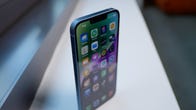

Now playing:
Watch this:
iPhone 14 Review: A Decent Upgrade for Most
9:53
The iPhone 14 Pro and Pro Max’s upgrades are more dramatic, but you still don’t need to upgrade unless you can score a great trade-in deal. Apple saved its most interesting new features for the Pro lineup, including the Dynamic Island that replaces the notch, the new A16 Bionic processor and a 48-megapixel main camera sensor. If you prefer larger phones, you may want to wait until Apple releases the iPhone 14 Plus before making your decision.
It’s important to remember that you don’t have to buy the iPhone 14 to get camera, battery and performance improvements over an earlier iPhone. The recently discounted $699 iPhone 13 or the smaller $599 13 Mini could be a good option if you still want more storage, faster performance and an improved camera, especially if you are coming from a phone that’s three years old or more. It’s also the only option if you want the smaller Mini and its 5.4-inch screen, since the iPhone 14 line eliminates that size in favor of the new $899 iPhone 14 Plus with a 6.7-inch screen.

Purchasing decisions will always vary depending on budget, how well your phone works right now and your personal needs, so there’s no simple answer that works for everyone. But here are the biggest differences between the iPhone 14 lineup and previous iPhone generations to help you make a decision.
Apple’s Newest Releases
- iPhone 14 Pro, Pro Max Review: Welcome to Apple’s Dynamic Island
- iPhone 14 Review: A Good Upgrade for Most People
- Apple Watch Series 8 Review: Improvement By Degrees
- Apple Watch SE Review: Almost Everything I Want
- Apple iOS 16 Released: New iPhone Features From the Update
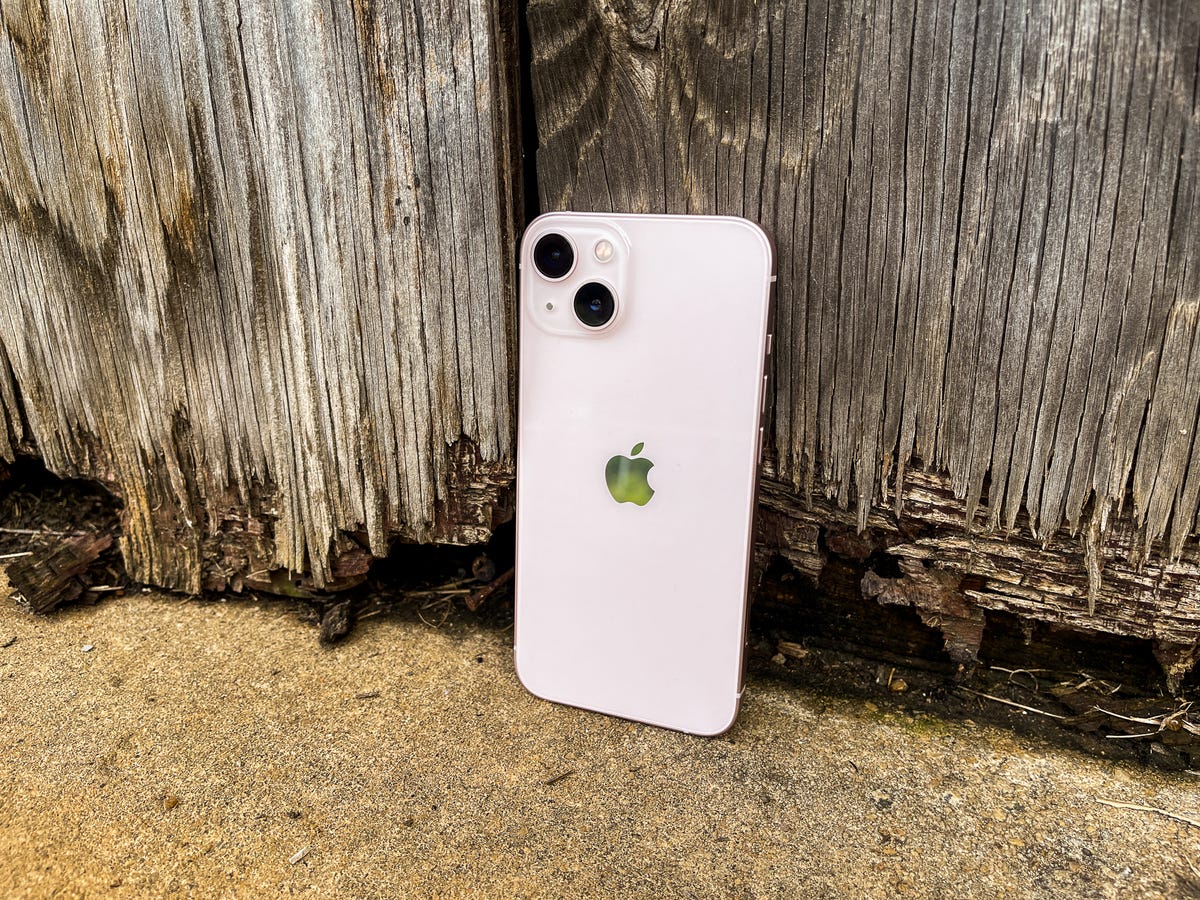

The iPhone 13.
Patrick Holland/CNET
iPhone 14 vs. iPhone 13, 13 Pro, 13 Pro Max
The iPhone 14 lineup introduces new features such as car-crash detection, the removal of the physical SIM card for US phones, and enhanced cameras on the rear and front. Despite those changes, iPhone 14 isn’t different enough to justify upgrading from the iPhone 13. And even though Apple finally got rid of the infamous notch in the Pro Models, the 14 and 14 Plus still have one — it’s the same smaller notch that debuted on the iPhone 13 series. In fact, the iPhone 14 represents “one of the most minimal year-over-year upgrades in Apple’s history,” according to CNET’s Patrick Holland, who reviewed Apple’s latest phones.
The iPhone 14 and iPhone 14 Plus have the A15 Bionic chip from last year’s iPhone 13 Pro and iPhone 13 Pro Max. The 14’s screen looks exactly like the one on the 13. Perhaps the most prominent change this year is the introduction of a larger version of the iPhone 14 called the iPhone 14 Plus, which has a 6.7-inch screen like the Pro Max. That means you no longer have to splurge on Apple’s most expensive iPhone if you want the largest screen possible.
Of course, the iPhone 14 is still highly rated, but we recommend saving your money and skipping the upgrade. If you’ve made up your mind to upgrade, we suggest going for an iPhone 14 Pro or iPhone 14 Pro Max if you can afford it. These phones are expensive, but buys you access to some salient changes — namely a high-refresh rate display, Apple’s new Dynamic Island multitasking bar, an always-on display as well as better cameras among other features.
The bottom line: If you have an iPhone 13 or 13 Pro, don’t upgrade. But if you are determined to get a new phone, go for the iPhone 14 Pro or 14 Pro Max, especially if you must have the Dynamic Island right now.
Read More: iPhone 14 Pro and 14 Pro Max Review
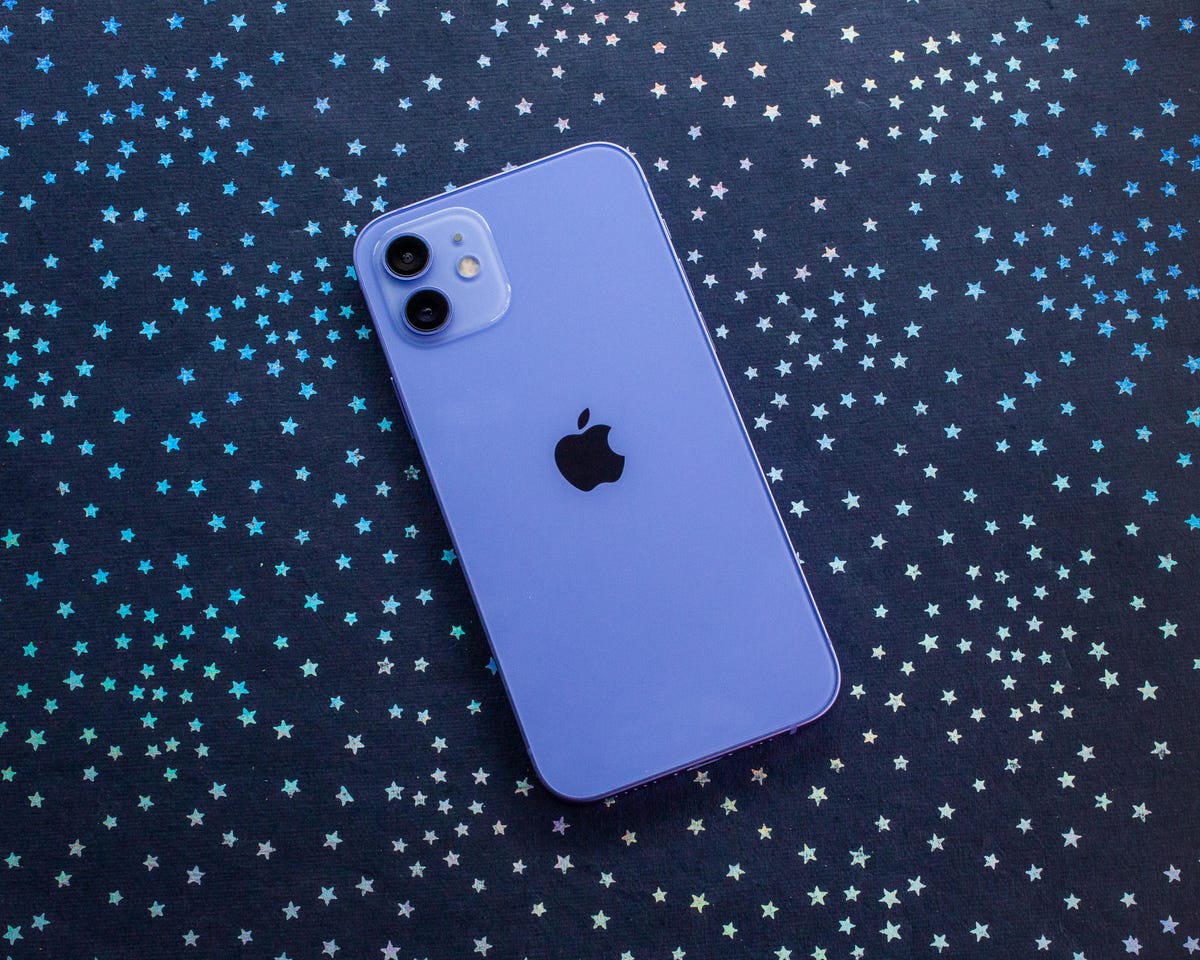

The iPhone 12.
Sarah Tew/CNET
iPhone 14 vs. iPhone 12, 12 Pro
Even though the iPhone 12 lineup was released two years ago, they still share many similarities with Apple’s latest phones. Both the iPhone 12 and iPhone 14 support 5G, run on fast processors, offer great cameras and include MagSafe accessory compatibility.
Since the iPhone 14 is more of a refresh than a major upgrade, we recommend hanging onto your iPhone 12 if it’s still in good condition. You can take advantage of the iPhone’s latest software features such as lock screen customizations, widgets and the ability to unsend text messages by upgrading to iOS 16.
The iPhone 14 received a few notable camera upgrades, like a larger sensor, a new lens with a faster aperture, improved photo processing and Action Mode which makes the movements in videos look smoother when you record them.
But the iPhone 12’s cameras remain excellent even though they are two years old. The iPhone 12 has a 12-megapixel dual camera system, while the iPhone 12 Pro includes a third camera with a telephoto lens. Check out our iPhone 12 review to see how the cameras held up when CNET put them through the paces.
It’s worth remembering that you get more noticeable upgrades with the iPhone 14 Pro and Pro Max. These include everything that’s new in the 14, as well as an upgraded main camera with a larger 48-megapixel sensor, an ultrawide camera that allows you to take Macro photos and a third camera with a telephoto lens. If you can get a good trade-in deal that significantly knocks down the iPhone 14 Pro’s price, upgrading from the regular iPhone 12 is a decent step-up.
The bottom line: Hold onto your iPhone 12 for another year since the iPhone 14 isn’t dramatically different. However, the iPhone 14 Pro and 14 Pro Max bring more significant changes that could be worthwhile if you can snag a good trade-in deal.
Read More: All The “New” iPhone Features That Have Been on Android For Years
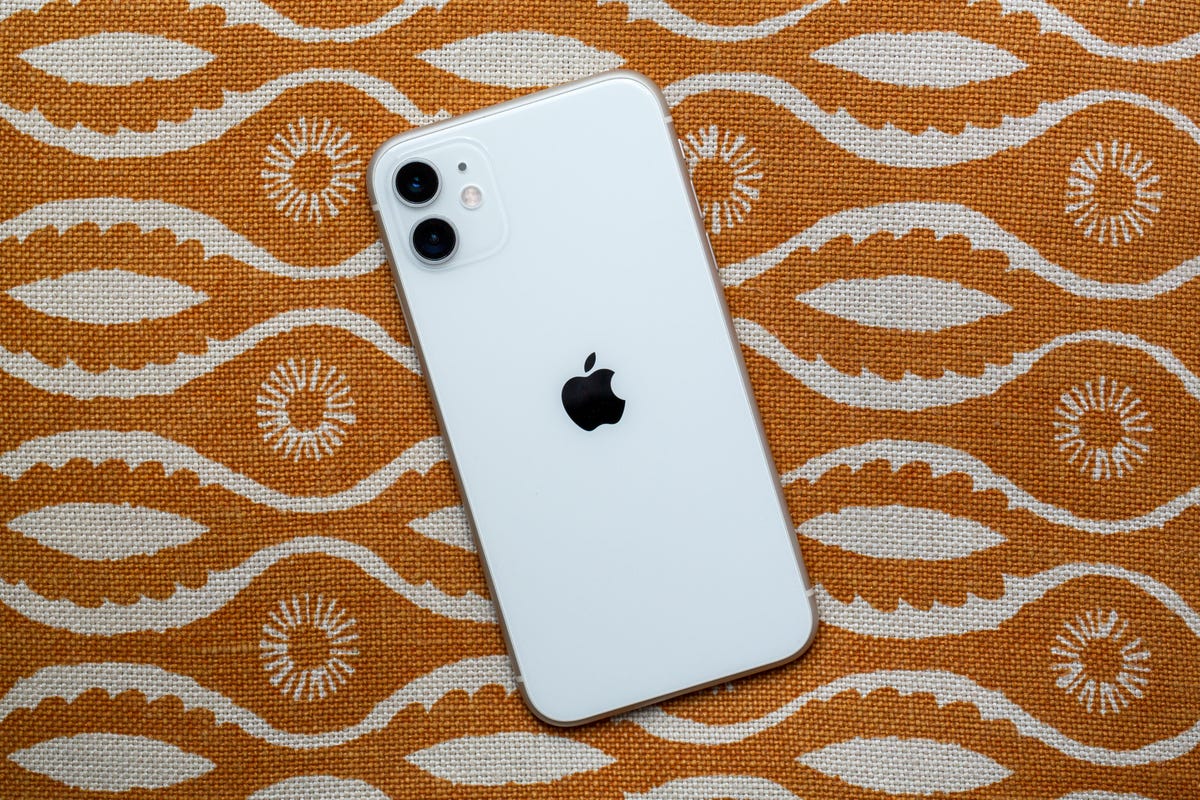

The iPhone 11.
Angela Lang/CNET
iPhone 14 vs. iPhone 11, 11 Pro
If you’re using an iPhone 11, we recommend upgrading to an iPhone 14 (or even an iPhone 13). In the last three years, Apple has made enough changes to features including battery life, performance, screen quality, cameras and durability to merit buying a new iPhone.
Upgrading to the iPhone 14 will get you 5G support, more storage (128GB at the base level versus 64GB) a better main camera with a wider aperture lens, new video shooting options like Action mode and Cinematic mode, a better selfie camera with Night mode and Apple’s Photonic Engine processing, compatibility with Apple’s MagSafe accessories, longer battery life and faster performance. That’s in addition to car-crash detection and Apple’s new emergency satellite messaging feature.
Most of the photography and videography improvements are dramatic changes compared to the iPhone 11. And the longer battery life and additional storage space are welcomed upgrades that you’ll notice on a daily basis.
As previously mentioned, if you go for the 14 Pro instead, you get a new 48-megapixel main camera, a closer 3x optical zoom versus the 11 Pro Max’s 2x zoom, the Dynamic Island instead of the notch and numerous other upgrades like an always-on display.
The bottom line: The iPhone 14 lineup includes enough changes to justify upgrading from the iPhone 11. But if your phone is still in good condition and you’re satisfied with it, install iOS 16 and hold onto it for another year.
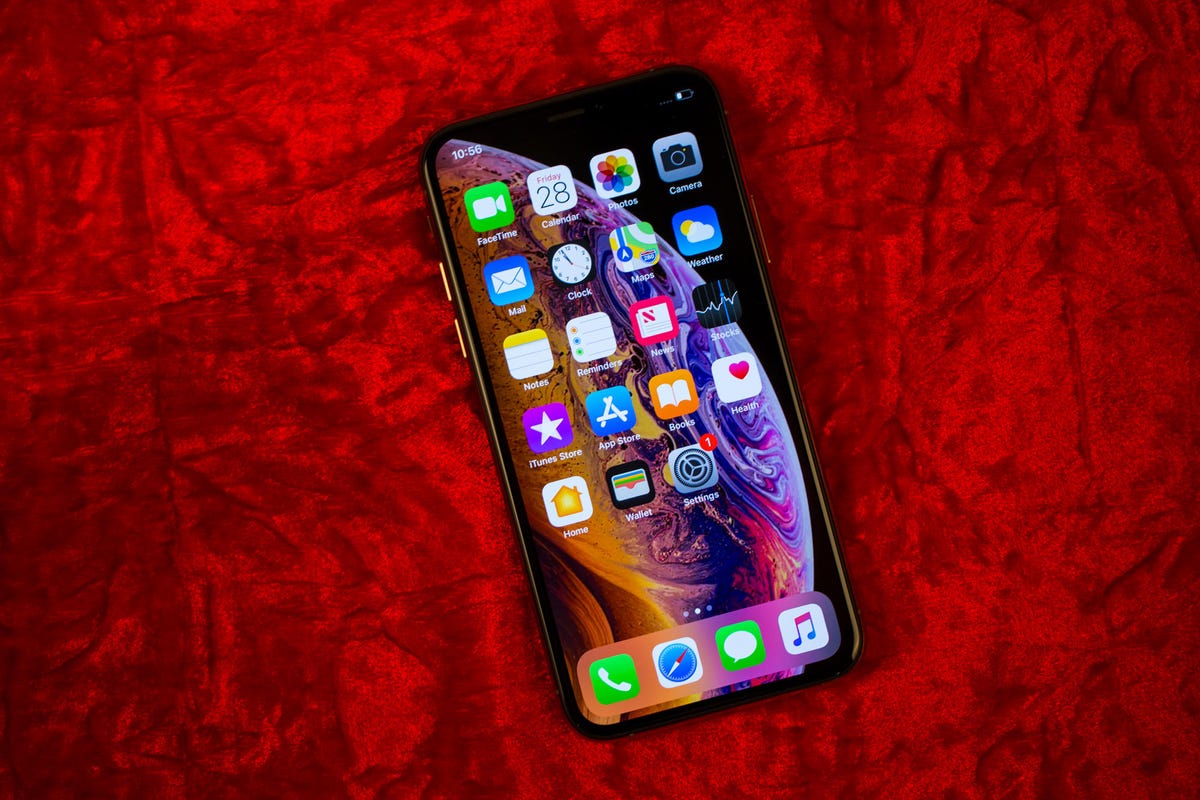

The iPhone XS
Josh Miller/CNET
iPhone 14 vs. iPhone XS, XS Max, XR
If you bought the iPhone XS, XS Max or XR at launch, that means your phone is roughly four years old and may be starting to feel sluggish. That alone makes a strong case for upgrading, but there’s plenty more to gain.
Compared to the iPhone XS, the iPhone 14 provides six hours of additional battery life (according to Apple’s estimates). In addition to everything that’s new in the iPhone 14 specifically, you’ll also get other upgrades Apple has added to the iPhone over the past few years.
Those include 5G support, more storage (again, you get 128GB versus 64GB), faster performance and a better camera. The iPhone XS generation lacks Night mode for taking clearer pictures in the dark, and it also doesn’t have Deep Fusion, which is Apple’s name for its image processing technique that improves detail and clarity in darker environments. The XS’s front camera has a lower 7-megapixel resolution compared to the larger and newer 12-megapixel sensor on the iPhone 14. If you’re upgrading from an iPhone XR, you’ll also get an additional camera with an ultrawide lens for taking broader group shots for the first time.
The iPhone 14 also has a larger 6.1-inch screen compared to the iPhone XS’ 5.8-inch display (the iPhone XS Max has a 6.5-inch screen, while the XR’s screen is also 6.1 inches). The design has also changed quite a bit over the past four years; newer models have flat edges, a slightly smaller notch, different finishes and a new “squircle”-shaped camera module that replaces the pill-shaped rear camera cutout. So your phone will not only feel more modern, but it’ll look newer, too.
The bottom line: If you have an iPhone XS, XS Max or XR, it’s definitely worth upgrading. You get a noticeable boost in camera quality, battery life and performance among other areas.
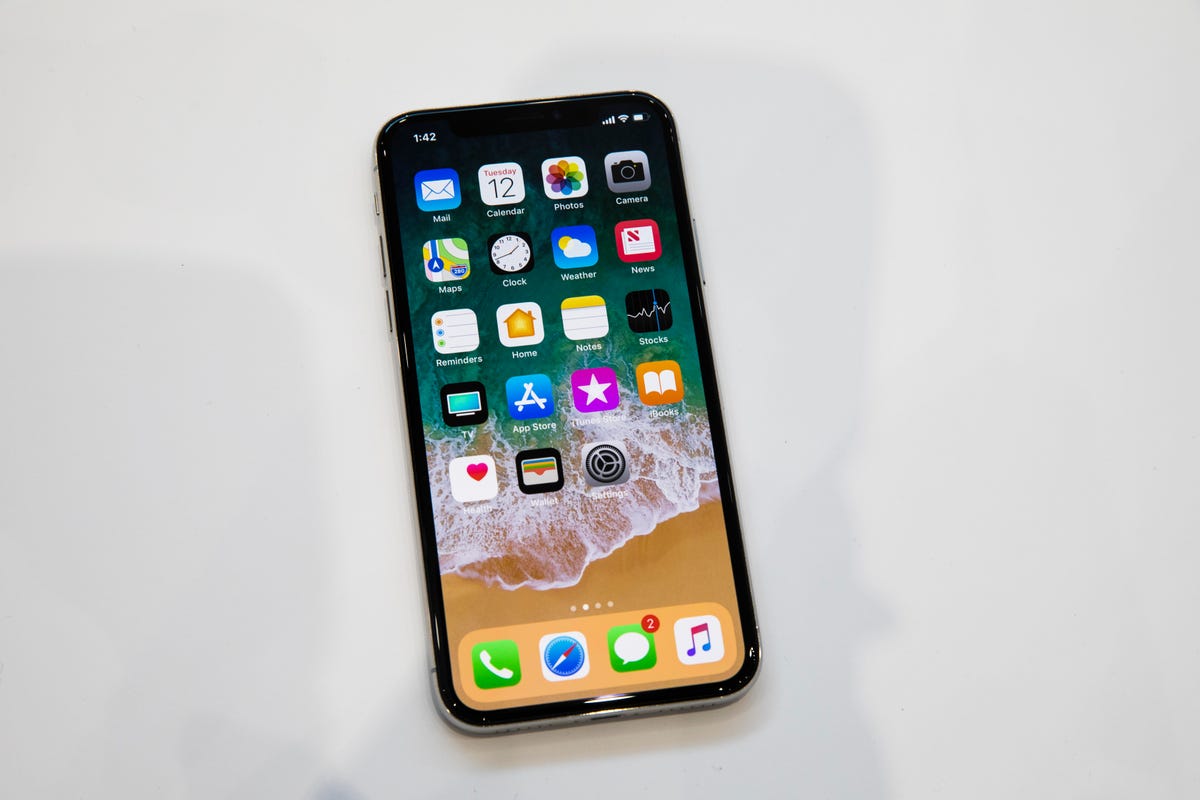

The iPhone X.
James Martin/CNET
iPhone 14 vs. iPhone X
The iPhone X is about five years old, which means it probably feels slow and its battery life isn’t what it used to be. With an iPhone 14, you’ll notice a major upgrade in both categories, as well as design, improved durability, connectivity and camera quality.
Let’s start with performance. The iPhone X runs on a much older A11 Bionic chip that’s now five years old, while the iPhone 14 runs on Apple’s A15 Bionic processor. The iPhone 14 Pro and Pro Max run on Apple’s newer A16 Bionic chip. Both new processors are way ahead of the A11 chip, which only has a two-core neural engine compared to the A15 Bionic’s 16-core neural engine.
The iPhone’s neural engine powers tasks that rely on machine learning and artificial intelligence, which are becoming a bigger part of the iPhone experience. Things like app suggestions in the App Library and Apple’s Translate app rely on machine learning to function, which indicates that the iPhone X may struggle to keep up with newer capabilities.
The iPhone X also has a dual-lens camera similar to that of the iPhone XS, meaning it’s missing the iPhone 14’s camera hardware improvements in addition to Night mode, Deep Fusion and the ability to control depth-of-field and blur levels in Portrait mode. Like the iPhone XS, you’re only getting a 7-megapixel front camera compared to a 12-megapixel selfie camera on Apple’s newer phones.
Apple’s five-year-old iPhone also has shorter battery life, with Apple estimating it should last for 13 hours when playing back video compared to 20 hours on the iPhone 14. The iPhone 14’s 6.1-inch screen is bigger than the 5.8-inch display on the iPhone X, and it should also be brighter since it can reach 800 nits of max brightness compared to the iPhone X’s 625-nit screen.
The iPhone 14 supports Dolby Atmos and spatial audio playback, while the iPhone X just has stereo playback. That’s probably not a deal-breaker, but might be crucial if you watch a lot of video on your phone without headphones.
And of course, there’s the benefit of getting car-crash detection, Apple’s new emergency SOS messaging via satellite option, better water resistance (up to 6 meters for 30 minutes versus 1 meter), 5G support, more storage space, Ceramic Shield for the display, a refreshed design and the option to use MagSafe accessories on the iPhone 14.
The bottom line: If you have the iPhone X, it’s time to upgrade. The iPhone 14 will feel new in just about every way, from the camera to performance, battery life and the way it looks and feels.
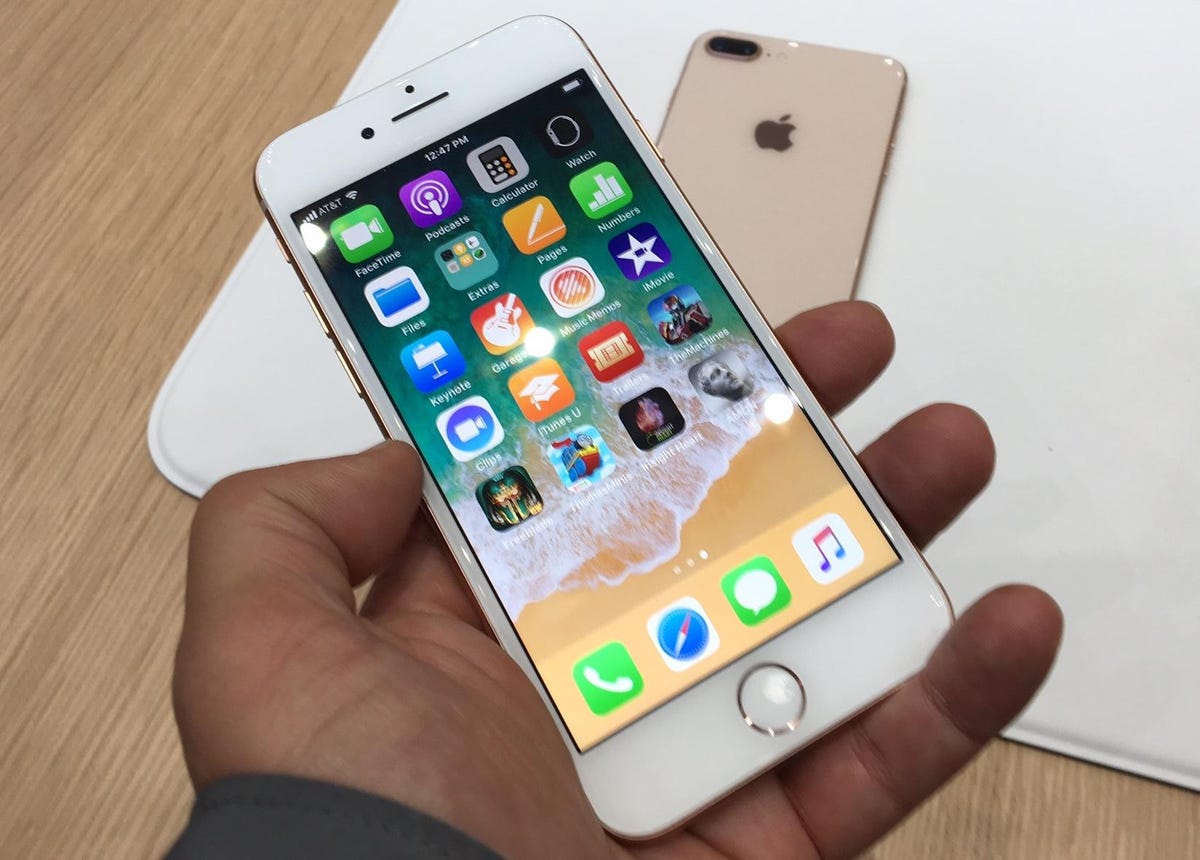

The iPhone 8 and 8 Plus.
Gabriel Sama/CNET
iPhone 13 vs. iPhone 8, 8 Plus
The iPhone 8 generation has Apple’s legacy iPhone design, which is fitting for a phone that’s now five years old. If you have an iPhone 8 and are considering an upgrade, many of the reasons to do that are the same as the reasons to upgrade from the iPhone X. The processor is getting old, which could make it harder to use newer iPhone features that rely on machine learning. The cameras are outdated and lack features like Night mode (the smaller iPhone 8 doesn’t have Portrait mode either, since it only has one lens). By upgrading, you’ll get more storage, significantly longer battery life, support for 5G connectivity and MagSafe accessories, too.
But the biggest difference is in the iPhone 8’s design, which is much more than just an aesthetic upgrade. Phones with Apple’s more modern edge-to-edge screen trade Touch ID for Face ID, which lets you unlock your phone and authenticate payments just by looking at your device. If you prefer Touch ID over Face ID, especially since it’s difficult to use Face ID while wearing a mask, you might want to at least consider upgrading to the $429 iPhone SE, since it has the same processor as the iPhone 13, 5G compatibility and plenty of photography improvements inside a similar body to the iPhone 8.
Upgrading to the iPhone 14 has a noticeably large jump in display size and quality. Since newer phones like the iPhone 14 don’t have a home button, there’s more room for Apple to expand the screen without making the device feel cumbersome. The iPhone 14’s screen is even larger than the iPhone 8 Plus’ 5.5-inch screen despite the device itself feeling more compact. (And for more perspective, consider that the iPhone 13 Mini has a 5.4-inch display). If you go for the 14 Pro you get another big change: the Dynamic Island, which transforms the notch area into an area for viewing alerts, system notifications and apps running in the background like Spotify or Apple Music.
From personal experience, switching from an iPhone 8 (which has a 4.7-inch screen) to the iPhone 12’s 6.1-inch display makes reading, checking email and watching videos much more comfortable. The screen isn’t only larger, but it’s also more vibrant with better contrast since it uses an OLED display rather than LCD.
The bottom line: The iPhone 14 is a huge jump from the iPhone 8. Everything about this phone will feel fast and new: the much larger and bolder screen, Face ID, the speedier processor, its longer battery life and of course the substantially upgraded cameras. Of note however, if you really want to get a newer iPhone but keep the iPhone 8’s design, trade up to the current 2022 iPhone SE.
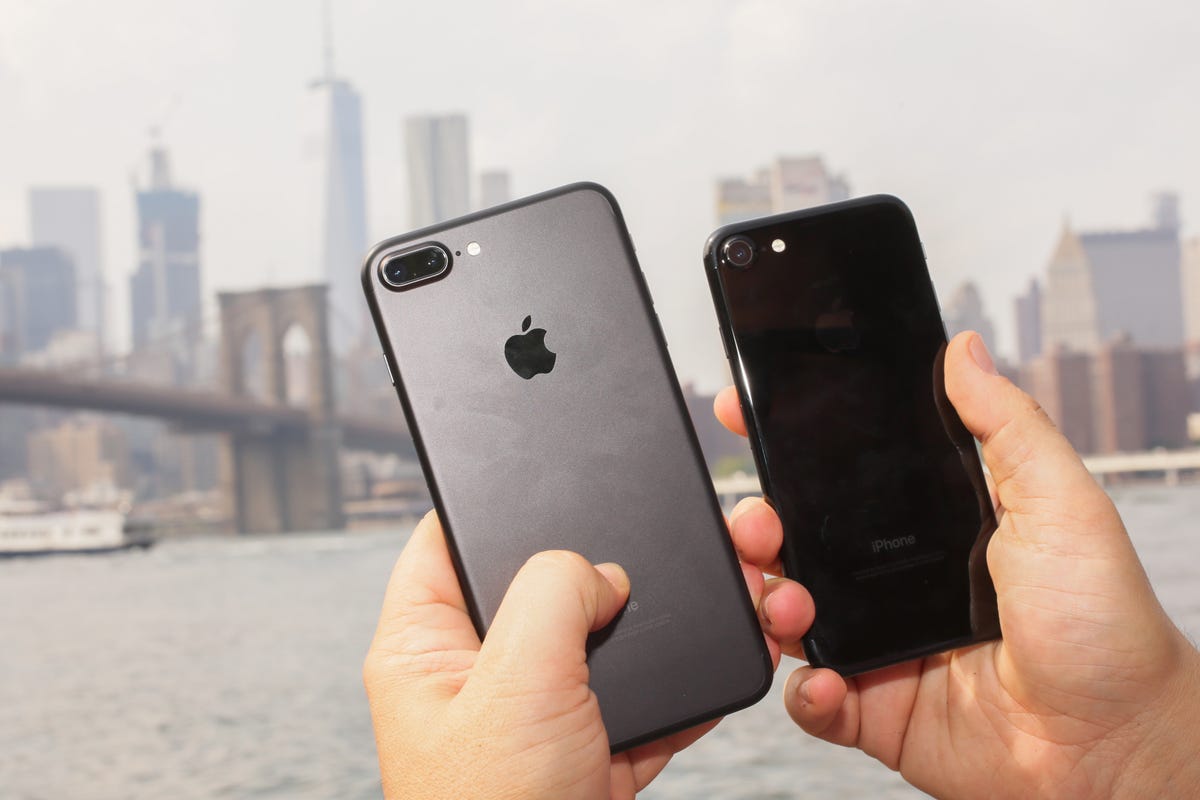

The iPhone 7 Plus and iPhone 7.
Sarah Tew/CNET
iPhone 13 vs. iPhone 7, 7 Plus
If you have an iPhone 7, it’s time to upgrade. It is six years old, and it shows in everything from the processor to the camera and storage space. The iPhone 7 doesn’t support iOS 16, providing even more incentive for acquiring a newer device.
While we generally recommend choosing the iPhone 14 Pro over the iPhone 14 in most cases, coming from a phone this old, means you’ll find plenty that’s new in the iPhone 14.
The iPhone 7 runs on an aging A10 Fusion processor, which doesn’t even have a neural engine and is several years behind Apple’s latest technology. It has a single-lens camera without Portrait mode, while the 7 Plus has two cameras. But those cameras lack many modern features like Night mode and Portrait Lighting, which adds specific lighting effects to your portraits.
Similar to the iPhone 8, the iPhone 7 series includes Touch ID and comes in either 4.7- or 5.5-inch screen sizes. But since the iPhone 7 is a year older than the iPhone 8, it’s also missing wireless charging, which means you must plug it in to charge.
If you’ve owned an iPhone 7 for several years, it’s probably bursting at the seams since it has substantially less storage space. The entry-level iPhone 7 only came with 32GB of space, which is a quarter of capacity available on the cheapest iPhone 14.
The iPhone 14 brings major gains in nearly every aspect. The standard model has a larger, bolder and brighter bezel-free 6.1-inch screen that still feels compact since it doesn’t have a home button. It runs on Apple’s A15 Bionic processor, which is better equipped to handle newer iOS features. And it has a drastically improved dual-lens camera with a larger main camera sensor and advanced features like the new Cinematic mode for video and Night mode. Plus, Apple’s estimates indicate it’ll offer seven hours of additional battery life during video playback, which is a huge bump.
The bottom line: If you’re still holding onto your iPhone 7, there’s no question that you’re due for an upgrade. A better screen, compatibility with iOS 16, longer battery life and more advanced cameras are just a few of the gains the iPhone 14 has to offer over the iPhone 7. And similar to my recommendation with the iPhone 8, if you really want to keep the home button and save some money, consider the iPhone SE. It gives you more recent performance upgrades while keeping a similar phone style.
The post Should You Upgrade to the iPhone 14? How It Compares to Older iPhones first appeared on Joggingvideo.com.
]]>The post What’s New in the iPhone 14: Everything Apple Changed Since iPhone 13 first appeared on Joggingvideo.com.
]]>This story is part of Focal Point iPhone 2022, CNET’s collection of news, tips and advice around Apple’s most popular product.
Apple’s new iPhone 14 and iPhone 14 Plus may look similar to last year’s iPhone 13 line, but there are a lot of new changes on the inside. The iPhone 14 line includes new sensors for car-crash detection, a photo processing method called Photonic Engine, the removal of the physical SIM card slot for US phones and improvements to both the rear and front-facing cameras. The most notable swap, however, are the phone line’s sizes: the Mini version is no longer offered as part of the iPhone 14 range, and instead the standard 6.1-inch phone ($799 £849, AU$1,399) arrives alongside a Plus model with a 6.7-inch display, starting at $899.
Apple isn’t done with the iPhone 13 yet though — the company will continue selling both the iPhone 13 and 13 Mini in its store with a modest price drop. The iPhone 13 line now starts at $599 for the Mini and $699 for the standard iPhone 13.
We’ve outlined in the chart the features of the iPhone 14 line against the iPhone 13 line, so you can compare the phones directly. The biggest deciding point could be the phone size: If you want a Mini phone then the iPhone 13 Mini is your only option. Similarly, if you want a larger phone and don’t want to spend over $1,000 for the iPhone 14 Pro Max, then the iPhone 14 Plus would be your pick. If deciding between the similarly-sized iPhone 13 and the iPhone 14, you should check if the iPhone 14’s new features and improved camera are worth the extra $100 for you.
You can also check out our comparison of the entire iPhone 14 lineup, along with explainers on the iPhone 14 Pro’s always on display, its 48-megapixel main camera and the new Dynamic Island feature.
Apple’s Newest Releases
- iPhone 14 Pro, Pro Max Review: Welcome to Apple’s Dynamic Island
- iPhone 14 Review: A Good Upgrade for Most People
- Apple Watch Series 8 Review: Improvement By Degrees
- Apple Watch SE Review: Almost Everything I Want
- Apple iOS 16 Released: New iPhone Features From the Update
Apple iPhone 14 vs. iPhone 14 Plus vs. iPhone 13 Mini vs. iPhone 13
| iPhone 14 | iPhone 14 Plus | iPhone 13 Mini | iPhone 13 | |
| Display size, resolution | 6.1-inch OLED; 2,532×1,170 pixels | 6.7-inch OLED; 2,778×1,284 pixels | 5.4-inch OLED; 2,340×1,080 pixels | 6.1-inch OLED; 2,532×1,170 pixels |
| Pixel density | 460 ppi | 458 ppi | 476 ppi | 460 ppi |
| Dimensions (inches) | 5.78 x 2.82 x 0.31 in. | 6.33 x 3.07 x 0.31 in. | 5.18 x 2.53 x 0.3 in. | 5.78 x 2.82 x 0.3 in. |
| Dimensions (millimeters) | 147 x 72 x 7.8mm | 161 x 78 x 7.8mm | 132 x 64 x 7.65mm | 147 x 72 x 7.65mm |
| Weight (ounces, grams) | 6.07 oz.; 172g | 7.16 oz.; 203g | 4.97 oz.; 141g | 6.14 oz.; 174g |
| Mobile software | iOS 16 | iOS 16 | iOS 15 | iOS 15 |
| Rear Cameras | 12-megapixel (wide), 12-megapixel (ultrawide) | 12-megapixel (wide), 12-megapixel (ultrawide) | 12-megapixel (wide), 12-megapixel (ultrawide) | 12-megapixel (wide), 12-megapixel (ultrawide) |
| Front-facing camera | 12-megapixel | 12-megapixel | 12-megapixel | 12-megapixel |
| Video capture | HDR video recording with Dolby Vision up to 4K at 60 fps | HDR video recording with Dolby Vision up to 4K at 60 fps | HDR video recording with Dolby Vision up to 4K at 60 fps | HDR video recording with Dolby Vision up to 4K at 60 fps |
| Processor | Apple A15 Bionic | Apple A15 Bionic | Apple A15 Bionic | Apple A15 Bionic |
| Storage | 128GB, 256GB, 512GB | 128GB, 256GB, 512GB | 128GB, 256GB, 512GB | 128GB, 256GB, 512GB |
| RAM | Undisclosed | Undisclosed | Undisclosed | Undisclosed |
| Expandable storage | No | No | No | No |
| Battery | Undisclosed; Apple lists 20 hours of video playback | Undisclosed; Apple lists 26 hours of video playback | Undisclosed; Apple lists 17 hours of video playback | Undisclosed; Apple lists 19 hours of video playback |
| Fingerprint sensor | No (Face ID) | No (Face ID) | No (Face ID) | No (Face ID) |
| Connector | Lightning | Lightning | Lightning | Lightning |
| Headphone jack | No | No | No | No |
| Special features | 5G enabled; Car crash detection; MagSafe; water resistant (IP68); wireless charging; dual-SIM capabilities (e-SIM) | 5G enabled; Car crash detection; MagSafe; water resistant (IP68); wireless charging; dual-SIM capabilities (e-SIM) | 5G enabled; MagSafe; water resistant (IP68); wireless charging; dual-SIM capabilities (nano-SIM and e-SIM) | 5G enabled; MagSafe; water resistant (IP68); wireless charging; dual-SIM capabilities (nano-SIM and e-SIM) |
| Price off-contract (USD) | $799 (128GB), $899 (256GB), $1,099 (512GB) | $899 (128GB), $999 (256GB), $1,199 (512GB) | $599 (128GB), $699 (256GB), $899 (512GB) | $699 (128GB), $799 (256GB), $999 (512GB) |
| Price (GBP) | £849 (128GB) | £949 (128GB) | £649 (128GB), £759 (256GB), £979 (512GB) | £749 (128GB), £859 (256GB), £1,079 (512GB) |
| Price (AUD) | AU$1,399 (128GB) | AU$1,579 (128GB) | AU$1,049 (128GB), AU$1,219 (256GB), AU$1,569 (512GB) | AU$1,229 (128GB), AU$1,399 (256GB), AU$1,749 (512GB) |

Apple IPhone 13
$629 at Apple



Now playing:
Watch this:
iPhone 14 Lineup: A Spec Comparison
7:09
The post What’s New in the iPhone 14: Everything Apple Changed Since iPhone 13 first appeared on Joggingvideo.com.
]]>The post What Will Apple’s iPhone 14 Look Like? We’ll Find Out Soon first appeared on Joggingvideo.com.
]]>This story is part of Focal Point iPhone 2022, CNET’s collection of news, tips and advice around Apple’s most popular product.
Apple’s rumored iPhone 14 is expected to debut today at its next launch event — follow our iPhone event live blog to stay up to date. But ahead of the big announcement, fans are wondering what the new iPhone will look like. Only Apple has the answer for now, although the ever-churning rumor mill has given us a few clues into the iPhone 14’s possible design.
We will be updating this story as we hear more, so be sure to bookmark this page for later. Here’s what we’ve heard so far, from gossip about a more durable titanium alloy body to a notchless screen. For more iPhone 14 rumors, check out everything we’ve heard about its release date and price. Plus, here’s all the new features we want to see.
More from the Apple Event
- New Apple Watch Series 8 Has a Temperature Sensor and Car Crash Detection
- Apple unveils AirPods Pro 2
- Apple Makes The iPhone 14, 14 Plus Official
- New Apple Watch Brings 36 Hours of Battery Life With Low-Power Mode
- New Apple Watch Ultra: Longer Battery, Titanium Design, Underwater Modes, More


Now playing:
Watch this:
Our iPhone 14 Wish List
8:35
iPhone 14 display: turning it down a notch
This one has persisted for years, but one of the biggest rumors is about what the iPhone 14 won’t have. After introducing the notch on the iPhone X back in 2017, Apple could finally ditch it this year. The company will trade it out for a smaller hole-punch camera in the Pro models, according to noted Apple analyst Ming-Chi Kuo. A hole-punch design refers to a display with only a small circular cutout for the front camera, as seen on a number of Samsung launches like the Galaxy S22 Ultra and Galaxy Z Flip 3.
Instead of a hole-punch design, display analyst Ross Young hypothesizes the iPhone 14 Pro and Pro Max will have a hole and pill-shaped cutout to accommodate the front-facing camera and Face ID. The pill-shaped cutout would hold the front and Face ID camera, while the hole-punch is believed to be for the Face ID dot projector, according to a January report from MacRumors. The hole-and-pill design is depicted in supposed renders of the Pro published by 91Mobiles. Meanwhile, alleged renders on MySmartPrice show the base iPhone 14 keeping the notch.
Right now, the notch is home to the components that make Face ID work, meaning Apple may need to shrink all that tech in order make a notchless iPhone a reality. Bloomberg’s Mark Gurman also hinted at the notch’s removal in his Power On newsletter in September last year, wherein he predicted a “complete redesign” for the iPhone 14.
The iPhone 14’s rumored hole-and-pill display emerged in schematics on Chinese social media site Weibo, and were later shared on YouTube by leaker Jon Prosser. Although we won’t know what the iPhone’s design will look like until it’s revealed, the schematics offer a glimpse at the next iPhone’s possible display.
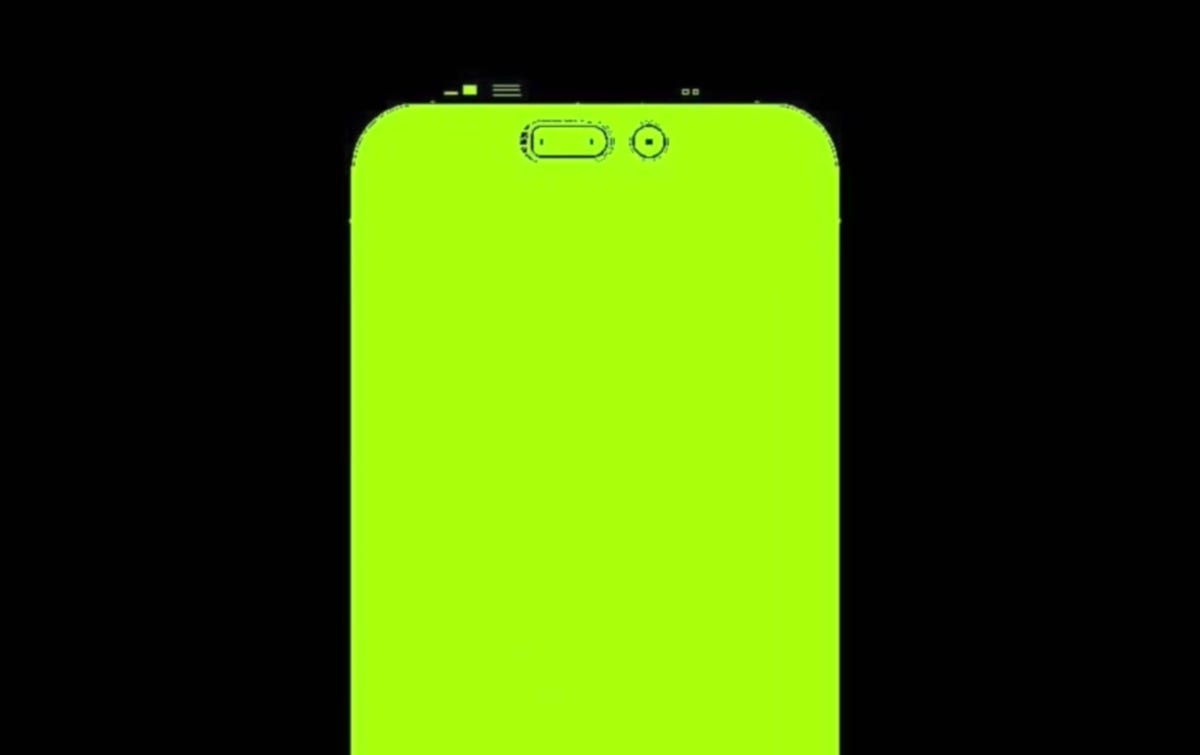

An alleged schematic of the iPhone 14’s display shared to YouTube by Jon Prosser.
Jon Prosser
iPhone 14 camera design: bumping down
Another design feature rumored to be on Apple’s list to remove is that chunky camera bump. The iPhone 13 lineup features a protruding camera bump, which houses two or three lenses depending on the model. According to Prosser, who has a hit-and-miss accuracy record, the iPhone of the future will eliminate the bump entirely, which could mean a thicker chassis for camera components. According to Prosser, the iPhone 14’s body is going to be a “thick boy.” But could it be thick enough to include all that camera hardware without the chunky camera setup on the back? I’m taking this rumor with a grain of salt.
Speaking of slimming things down, leaker ShrimpApplePro tweeted that the Pro Max version of the iPhone 14 will come with smaller bezels than those of the iPhone 13 Pro Max.
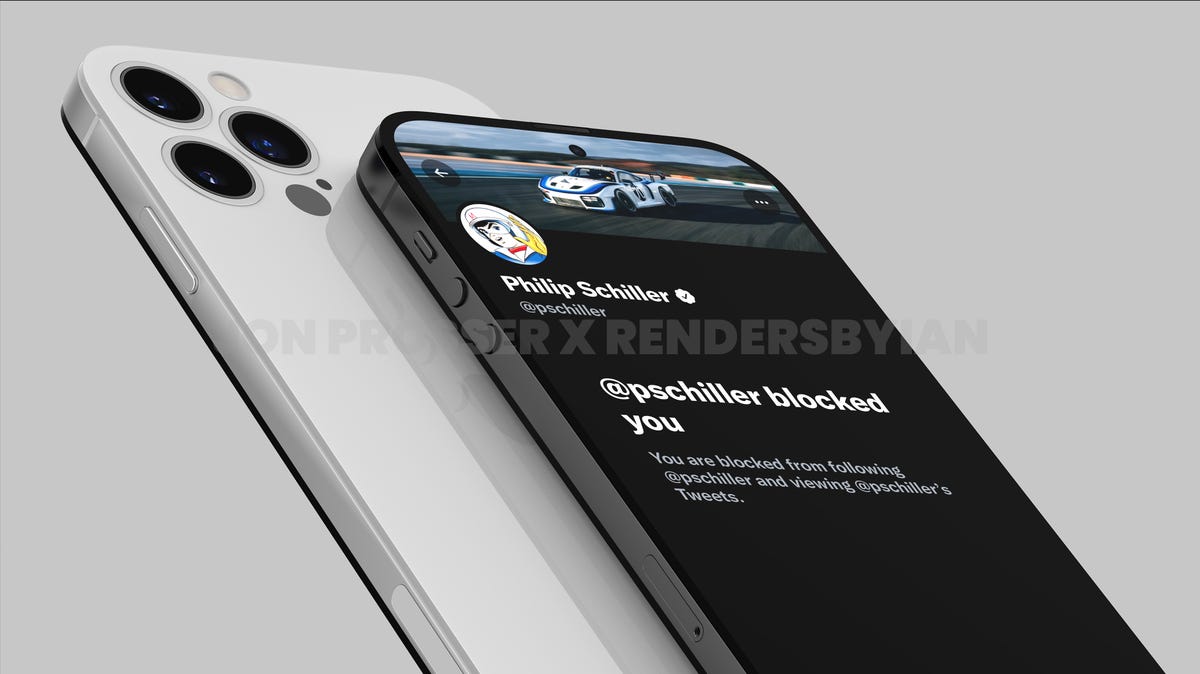

Early renders of the iPhone 14 from Jon Prosser suggest a notchless design and flush camera setup.
Jon Prosser
iPhone 14 chassis: tougher and lighter
Speaking of the iPhone’s chassis, Prosser also said the iPhone 14 Pro could receive a titanium alloy body for the first time, replacing the stainless-steel one. This rumor was first referenced in a 2021 report by JP Morgan Chase’s China office. Apple has previously used titanium alloy in select Apple Watch models, including the Series 7. Titanium alloy rivals steel in toughness, while also weighing less than stainless steel. Titanium is also more resistant to scratches, corrosion and bending.
iPhone 14 size: same-but-different bezels for Pro models
Apple’s last two iPhone lineups have featured the same 6.1-inch size for the base model, going up to 6.7 inches for the Pro Max. According to a Nikkei Asian Review report in July last year, Apple will stick with these sizes for the iPhone 14 series, but eliminate the 5.4-inch Mini. This rumor is corroborated by a March report from 9to5Mac. Reports showed sluggish sales of the iPhone 12 Mini, so it’ll be no surprise if Apple ends up retiring the small phone in 2022.
Although the size of the next iPhone is expected to stay the same, the display bezels for the Pro Max are rumored to be 20% smaller compared to previous iPhone generations, according to CAD renders shared in April by Twitter leaker ShrimpApplePro. This means the screen would be slightly larger. However, it’s important to note that this rumor should be taken with a grain of salt since ShrimpApplePro doesn’t have an extensive track record to support their speculations.
Will the iPhone 14 fold?
Probably not. To be clear, we can’t say for certain whether a foldable iPhone will ever see the light of day, but I’m holding out hope that it could happen in the next few years. A Bloomberg report published in January said Apple already has a working prototype of a foldable iPhone display, but didn’t confirm a launch timeline. Other outlets, including Taiwan’s Economic Daily, pinned down 2022 as the year the foldable iPhone will come to fruition, while others suggest 2023. Display analyst Ross Young, however, suggests the foldable iPhone could be delayed until 2025.
Remember, the iPhone 13 was an incremental upgrade from iPhone 12. That means it’s potentially setting the stage for a sweeping design overhaul when the iPhone 14 or 15 comes around, just as Apple revamped its phones’ look with the iPhone X.
Apple’s Newest Releases
- iPhone 14 Pro, Pro Max Review: Welcome to Apple’s Dynamic Island
- iPhone 14 Review: A Good Upgrade for Most People
- Apple Watch Series 8 Review: Improvement By Degrees
- Apple Watch SE Review: Almost Everything I Want
- Apple iOS 16 Released: New iPhone Features From the Update
The post What Will Apple’s iPhone 14 Look Like? We’ll Find Out Soon first appeared on Joggingvideo.com.
]]>The post Apple Watch 8: Every Rumor to Know Before the Big Reveal first appeared on Joggingvideo.com.
]]>
The Apple Watch Series 8 is expected to be announced alongside the rumored iPhone 14 at the company’s launch event today, and could mark a couple of milestones for Apple’s popular smartwatch. It might be the first to come in a new “Pro” version for extreme sports and included a temperature sensor. That’s if reports from Bloomberg and The Wall Street Journal turn out to be true.
Read more: Apple Event 2022: How to Watch Today’s iPhone 14 Reveal Live
The Series 7, which Apple unveiled alongside the iPhone 13 lineup last September, didn’t receive many significant changes apart from its enlarged screen, faster charging and improved durability. Other than the expected temperature sensor, the standard Series 8 may follow the same route. Bloomberg reports the Series 8’s hardware will be generally similar to that of the Series 7.
We’ll know for sure once Apple announces its next smartwatch. The company is expected to introduce the Series 8, a Pro version of the Series 8 and a new Apple Watch SE soon. Until then, current Apple Watch owners will get new software features when WatchOS 9 debuts this fall.
Read more: Best Smartwatches for 2022
Apple’s Newest Releases
- iPhone 14 Pro, Pro Max Review: Welcome to Apple’s Dynamic Island
- iPhone 14 Review: A Good Upgrade for Most People
- Apple Watch Series 8 Review: Improvement By Degrees
- Apple Watch SE Review: Almost Everything I Want
- Apple iOS 16 Released: New iPhone Features From the Update
Health: Apple Watch Series 8 may debut a temperature sensor
Years before the pandemic, Apple already held long-term health ambitions for its popular wrist accessory, with CEO Tim Cook describing health as Apple’s “greatest contribution to mankind.” And according to reports by Bloomberg and The Wall Street Journal, Apple may further those ambitions with the addition of a temperature sensor in the Apple Watch Series 8.
The temperature-sensing feature could bring new fertility planning tools to Apple’s smartwatch, according to the reports. A more recent Bloomberg report suggests the Series 8 may be able to detect fevers. But that doesn’t mean you should expect to get a specific temperature reading like you would when using a standard thermometer. Instead, Bloomberg says it will likely be able to tell whether you might have a fever and would recommend using a dedicated thermometer or consulting a doctor.
There are also a number of other health features in Apple’s pipeline, according to the reports, though such tools are said to still be in development. They include glucose monitoring, a tool that alerts users if their blood oxygen level drops, sleep apnea detection and blood pressure monitoring, according to the Journal and Bloomberg. But these features are expected to be far off and likely won’t appear in the Apple Watch for years. Bloomberg reported that the blood pressure tool wouldn’t be ready until 2024 at the earliest.
The blood pressure tech would likely work by using sensors to measure the speed of the wave a heartbeat sends through a person’s arteries, reports the Journal. Unlike traditional blood pressure monitoring cuffs, which are usually strapped around the upper arm, it wouldn’t provide baseline systolic and diastolic blood pressure measurements. Instead, it would tell you how your blood pressure is trending, the report said. Samsung has previously incorporated a similar blood pressure feature in the Galaxy Watch 4, which is available in some countries and regions like South Korea and Europe, where it’s received regulatory approval.
Read more: A New Apple Watch SE Sounds More Exciting Than the Series 8
A new model: The rugged Apple Watch Pro
According to Bloomberg, Apple will launch its largest smartwatch yet this fall. This new model, which has been referred to as the Apple Watch Pro or Apple Watch Explorer Edition, will reportedly have a larger nearly 2-inch screen, a bigger battery and a more durable exterior compared to the standard flagship model. This watch would be targeted toward those who participate in extreme sports and other adventurous outdoor activities.
The display increase means the Apple Watch Pro will have 7% more screen space than the current largest Apple Watch, which is the Series 7, according to the report. That could pair nicely with the new watch faces fitness statistics Apple just announced in WatchOS 9. Bloomberg has been reporting on this new rugged Apple Watch since last year but recently published newer details on the screen size and larger battery.
Design: Apple Watch Series 8 may get a new size
By and large, the overall aesthetic of the Apple Watch has remained virtually unchanged since the original one made waves back in 2015. But rumors suggest Apple may add another new Apple Watch size after enlarging the display of the Series 7. According to posts on Twitter by display analyst Ross Young, a third size of the Apple Watch may come to fruition this year. Bloomberg also says there’s been some internal discussion about the Series 8 getting an updated display, but it’s unclear if that means its size would change.
However, there’s a chance this new display size may be exclusive to the so-called Apple Watch Pro. A July 6 report from Bloomberg says the new rugged Apple Watch will have a screen measuring almost two inches diagonally, while the regular Series 8’s display will be the same size as the Series 7’s.
Performance: Similar to the Series 7
Apple isn’t planning on making major changes to the Series 8’s performance, according to Bloomberg. The Series 8’s processor reportedly has the same specifications as the Series 7’s chip, which already shares many similarities with the Series 6’s chip. Apple is saving a more significant processor update for next year’s Apple Watch, Bloomberg reports.
The decision to essentially keep the same processor for three Apple Watch generations is significant. It suggests the Apple Watch has matured to the point where year-over-year performance changes aren’t very dramatic. Instead, the biggest areas where the Apple Watch is showing signs of growth involve health tracking and new software features, as Apple has shown with WatchOS 9.
Battery life: A new low-power mode
Since the Series 8 is expected to have a processor that’s similar to the Series 7’s, I’d expect battery life to remain the same, too. But the Series 8 might get a different update aimed at extending battery life: a new low-power mode. Bloomberg previously reported that WatchOS 9 would include a new low-power mode that would allow the watch to run certain apps and features while conserving battery life. That feature didn’t make it into Apple’s latest software update, but a more recent Bloomberg report suggests that it could arrive as an exclusive for Apple’s next-generation smartwatch. The rumored Apple Watch Pro is also said to have a larger battery, according to Bloomberg.
Looking for more Apple updates? Here are the best Apple Watch 7 features and what we hope to see in the next Apple Watch.
The post Apple Watch 8: Every Rumor to Know Before the Big Reveal first appeared on Joggingvideo.com.
]]>The post After iPhone 14 Reveal, the iPhone 11 Could Be a Great Bargain first appeared on Joggingvideo.com.
]]>This story is part of Focal Point iPhone 2022, CNET’s collection of news, tips and advice around Apple’s most popular product.
It’s been three years since the debut of the iPhone 11, with Apple launching the iPhone 13 and iPhone 12 in the years since. And at Wednesday’s Apple event, we got all the news about the imminent iPhone 14, which will become available on Friday, Sept. 16.
Apple’s Newest Releases
- iPhone 14 Pro, Pro Max Review: Welcome to Apple’s Dynamic Island
- iPhone 14 Review: A Good Upgrade for Most People
- Apple Watch Series 8 Review: Improvement By Degrees
- Apple Watch SE Review: Almost Everything I Want
- Apple iOS 16 Released: New iPhone Features From the Update
Although the iPhone 11 is almost three years old, it might still be a good choice for many iPhone users, especially if the price drops considerably after Apple’s “Far Out” event today. Prices for earlier iPhone models usually decrease after the official announcement of new models. Even if its price doesn’t drop much, the iPhone 11 still has a lot to like for a phone that’s under $500.
Do you mind using an iPhone that feels a bit dated? Or do you think saving several hundred dollars is more important than carrying the latest phone? What about 5G — how important is that to you? If you’re shopping on a budget, the iPhone 11 is still a great choice. Although you’ll be missing out on some newer features, the iPhone 11 gives you all the basics you’d want from an iPhone, including battery life that’s on par with the iPhone 12, a great dual-lens camera that includes night mode and a processor that’s still fast enough for everyday tasks.
But if you have some wiggle room in your budget, here are some questions to ask yourself. (For the purposes of this article, I’m going to assume that you are currently using an iPhone.) And if you’re still mulling over your decision after these questions, be sure to peruse our list of the best iPhones and check out all the differences between the iPhone 11, 11 Pro and 11 Pro Max.
iPhone 11
$499 at Apple

iPhone 13
$799 at Apple

5G connectivity: iPhone 11 doesn’t have 5G. But do you really need it right now?
One of the iPhone 11’s biggest missing features compared to the iPhone 13 and iPhone 12 is 5G connectivity. The iPhone 11 is an LTE-only device, and if you don’t care for the next-gen wireless tech just yet (service is patchy in the US after all), then the iPhone 11 should suit you just fine. Remember that 5G debuted on the iPhone 12 lineup and getting access to faster bands of 5G depends on where you live, so going for the iPhone 12 makes your purchase more future-proof.
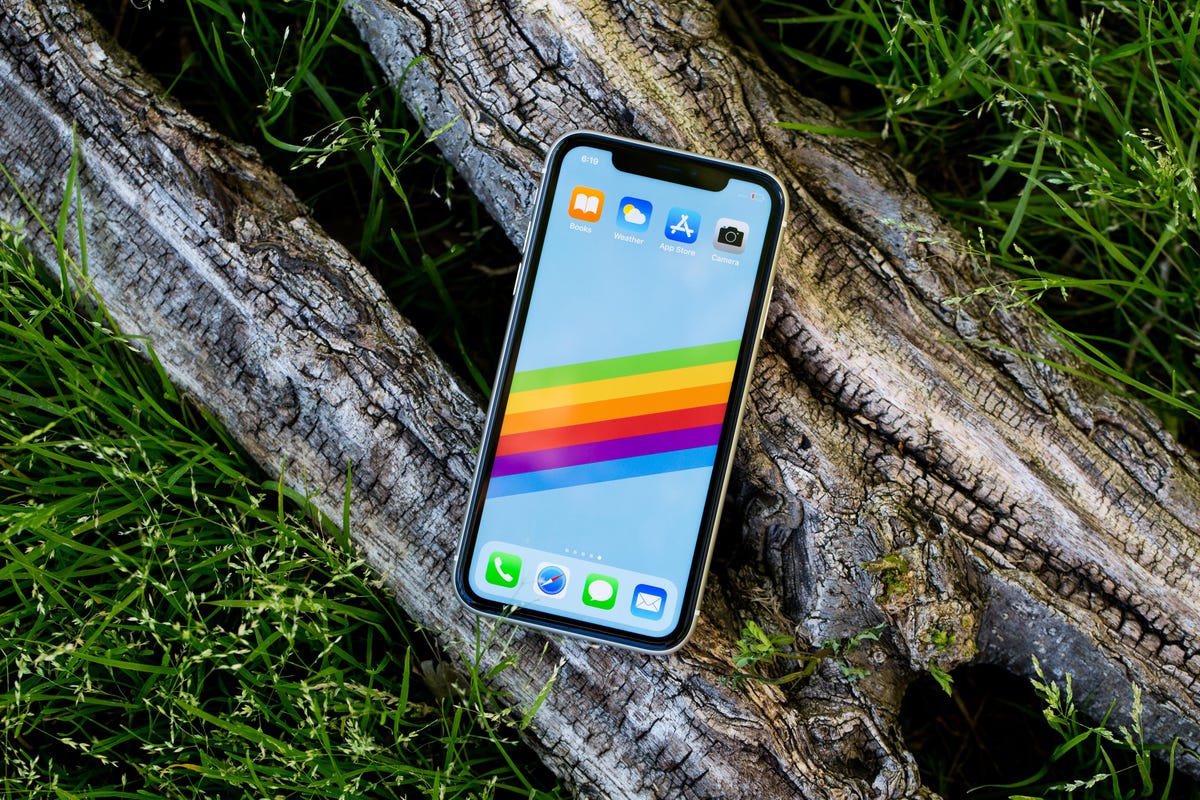

Angela Lang/CNET
Display quality: You won’t get a 120Hz refresh rate on an iPhone 11 (or iPhone 12)
The iPhone 11 uses a crisp LCD screen that refreshes at 60 frames per second, or 60Hz. Apple traded up in the iPhone 12, equipping it with an OLED screen, though it kept the display at 60Hz just like most phones. OLEDs are typically more vibrant than their LCD counterparts, with richer contrast and inkier blacks. If you watch a lot of videos on your iPhone and want a superior viewing experience, an OLED screen might make more sense for you. The iPhone 13 also boasts an OLED panel too, though Apple bumped up the refresh rate for the Pro models to 120Hz. The faster refresh rate will translate to smoother, snappier scrolling through apps and websites.
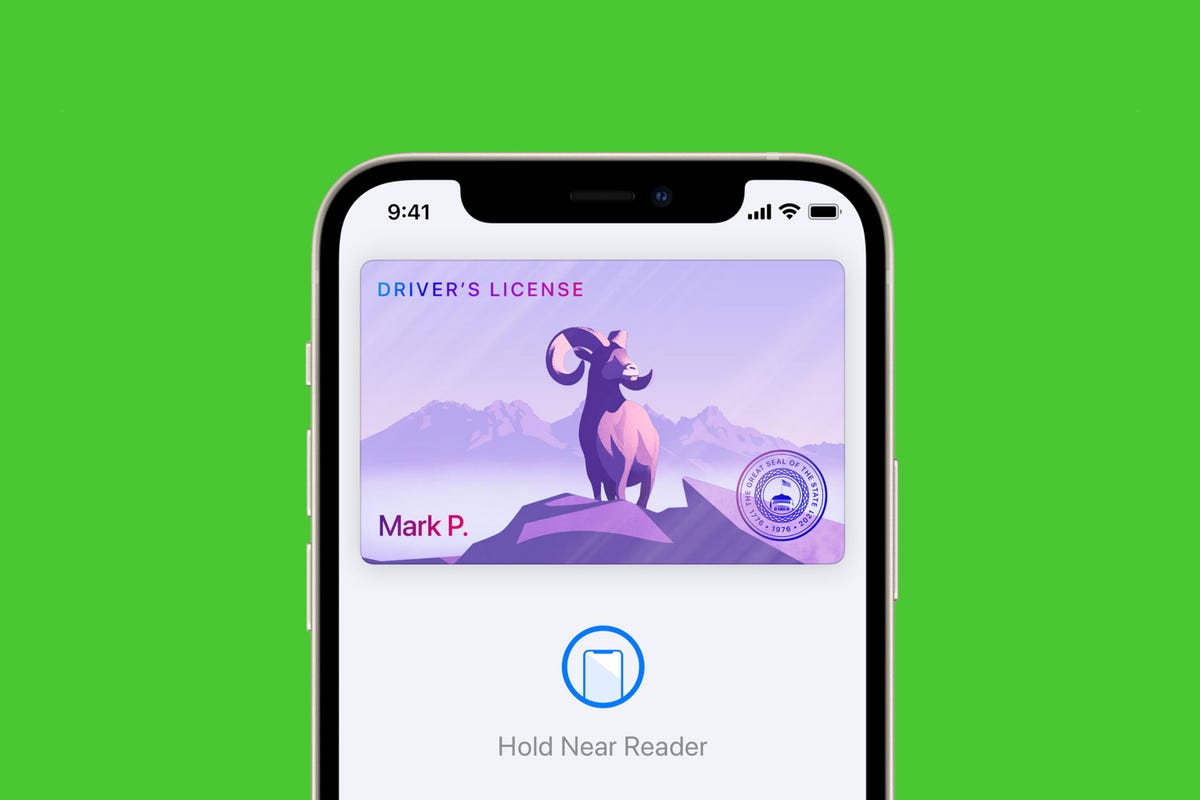

Apple’s Wallet app will be able to store driver’s licenses in iOS 15.
Screenshot by CNET
Software support: How long will the iPhone 11 get iOS software updates?
Apple’s latest operating system, iOS 15, is supported on many older iPhones, and the oldest is the 2015 iPhone 6S (Here’s how to download the new OS, but you may want to wait.) Based on that and some quick mental math, we can deduce that Apple plans to provide iPhone support for up to six years from launch. As a result, with the iPhone 11, unveiled in 2019, you can rest comfortably knowing that you can expect updates through 2025.
Read more: iOS 16: All the Cool, New Features Coming to Your iPhone
Durability and water resistance: How durable do you want your iPhone to be?
If you do opt for the iPhone 11, you will miss out on a few durability features that are available on the newer iPhone models. One of the iPhone 12’s big improvements is the material of its display. Apple calls it “ceramic shield” glass. Made by Corning, the ceramic shield glass covering the phone’s display is apparently harder than most metals. Indeed, we can confirm that the iPhone 12’s ceramic shield is tough. Our iPhone 12 drop tests show it protected the hardware from drops as high as 9 feet. (CNET’s iPhone 12 Mini drop tests yielded similar results.) The iPhone 13 also has the same ceramic shield glass on its display.
So if you’re a big klutz and are prone to slips and drops, springing for the iPhone 13 or iPhone 12 is a wise move (or just get a really nice iPhone case). Keep in mind, the iPhone 11 isn’t a delicate darling, either. It also survived CNET’s drop and water tests and earned a CNET Editors’ Choice Award. You can read our iPhone 11 review for more details.
Read more: Farewell iPhone case: The case for the caseless phone
Price and budget: How much do you want to spend on an iPhone?
Before its fall 2022 “Far Out” event, Apple was selling the nearly three-year-old iPhone 11 for $499, making it a good choice for those shopping on a budget. Now that the iPhone 14 has been officially released, the company no longer sells the iPhone 11 on its website — you’ll need to check licensed resellers in order to compare prices. It’s worth noting that the current iPhone 12 and 12 Mini might come down in price and hit that same $499 level, as typically Apple lowers the price of existing iPhone models after the newest model goes on sale. As of Sept. 7, Apple is still selling the iPhone 12 starting at $599.
iPhone buyers looking for a deal should also consider carrier deals from Verizon, T-Mobile and AT&T, all of which may subsidize the price of an iPhone in exchange for committing to a cellular service plan. Last year the three companies offered hundreds of dollars off with those contracts, and could even pay off the phone entirely with a device trade-in. Just keep in mind that there are plenty of caveats to those deals, such as service commitments ranging from 24 to 36 months.
iPhone 11 and 11 Pro in all their new, vibrant colors
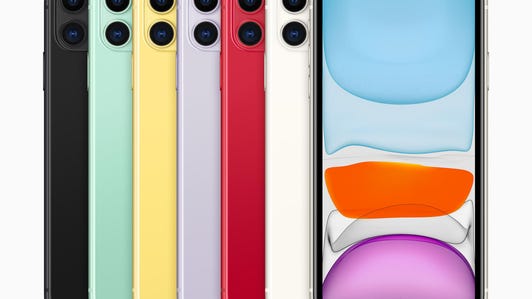



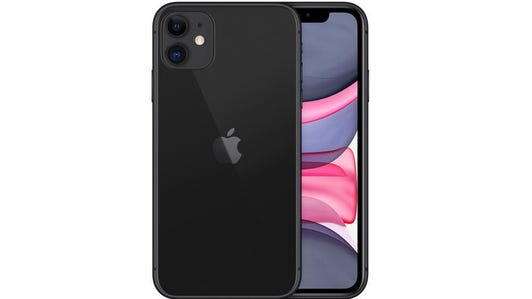

+17 more
The post After iPhone 14 Reveal, the iPhone 11 Could Be a Great Bargain first appeared on Joggingvideo.com.
]]>The post Galaxy Z Flip 4 vs. Z Fold 4: Samsung’s New Foldable Phones Compared, Spec by Spec first appeared on Joggingvideo.com.
]]>
Samsung revealed the Galaxy Z Fold 4 and Galaxy Z Flip 4 at its annual Unpacked event last week, marking a continuation of the phonemaker’s efforts to take foldable phones to the mainstream. The phones, which were unveiled alongside the Galaxy Watch 5 and Galaxy Buds 2 Pro, will launch on Aug. 26. The Galaxy Z Fold 4 will start at $1,800 (£1,649, AU$2,499), while the Galaxy Z Flip 4 will start at $1,000 (£999, AU$1,499) — each the same price as its predecessor.
While both phones have a foldable design, the specific look and feel is different for each. The Z Flip 4 is a clamshell-style flip phone popularized by Motorola’s Razr. It’s compact, nostalgically cool and it targets online content creators, among other demographics. The Z Fold 4, on the other hand, is Samsung’s heftier book-style foldable. It’s nearly double the height of the Z Flip 4 when both are folded “closed.” When unfurled, Z Fold 4 expands into a tablet-sized interior screen that Samsung says is a powerful tool for multitasking, which is given a boost by 12GB of RAM.
More from Samsung Unpacked
- Samsung Unpacked: Galaxy Z Fold 4, Z Flip 4 and Every Reveal
- Samsung Galaxy Z Fold 4: Better Design, Same High Price
- Samsung’s Galaxy Z Flip 4 Gets New Software Tricks
With the Z Fold 4’s larger size (and higher price), comes a corresponding set of features. There are three rear cameras including a telephoto lens, compared with just two on the Z Flip 2. The Z Fold 4 also manages to cram in a larger battery. Their front displays are different, too. The Z Flip 4 has a petite display on the lower portion of the cover, which Samsung has made more useful with this iteration. The Z Fold 4’s display is nearly the size of a regular phone screen.
Samsung Z Fold 4: See trade-in options
See at Samsung
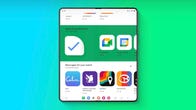
Despite their physical differences, perhaps Samsung’s biggest flex was software, and the changes affected both new models. Like the Z Fold 4, the Flip 4 gets the bottom-screen trackpad feature in its Flex Mode — that’s the feature that splits apps between top and bottom portions of the screen when it’s folded halfway. With the updates, you’ll be able to use the bottom half of the screen as a trackpad for navigating the top portion of the screen, supposedly making it easier to manipulate apps in Flex Mode.
Samsung Galaxy Z Flip 4: See trade-in options
See at Samsung

Each model also receives nighttime photography improvements that were launched with the Galaxy S22, including night portrait-mode photos. These changes seem to underscore Samsung’s efforts to convince shoppers to switch to a foldable phone — or at the very least generate some interest in one.
For more information on how the Z Flip 4 stacks up against the Z Fold 4, take a look at CNET’s specs chart below for a side-by-side comparison.
Z Fold 4 vs. Z Flip 4
| Galaxy Z Fold 4 5G | Galaxy Z Flip 4 | |
|---|---|---|
| Display size, resolution, aspect ratio | Internal: 7.6-inch AMOLED (2176 x 1812 pixels) External: 6.2-inch HD Plus (2,316 x 904) | Main Screen: 6.7-inch FHD+ (2,640 x 1080 pixels; 22:9) Cover Screen: 1.9-inch (260×512 pixels) |
| Pixel density | TBC | TBC |
| Dimensions (Millimeters) | Folded: 67.1×155.1×15.8mm (Hinge) ~14.2mm (Sagging). Unfolded: 130.1×155.1×6.3mm | Folded: 71.9×84.9×17.1mm (Hinge) ~15.9mm (Sagging). Unfolded: 71.9×165.2×6.9mm |
| Weight (Ounces, Grams) | 9.27 oz; 263g | 187g; 6.59 oz |
| Mobile software | Android 12L | Android 12 |
| Camera | 50-megapixel (main), 12-megapixel (ultra-wide), 10-megapixel (telephoto) | 12-megapixel (main), 12-megapixel (ultra-wide) |
| Front-facing camera | 4-megapixel (under display), 10-megapixel (front cover) | 10-megapixel |
| Video capture | 4K | 4K |
| Processor | Snapdragon 8 Gen Plus 1 | Snap 8 Plus Gen 1 |
| RAM/Storage | 12GB + 256GB/512GB/1TB | 8GB+ 128GB/256GB/512GB |
| Expandable storage | None | None |
| Battery/Charger | 4,400 mAh | 3,700 mAh |
| Fingerprint sensor | Side | Side |
| Connector | USB-C | USB-C |
| Headphone jack | None | No |
| Special features | Foldable phone, 30x optical, 30x space zoom, IPX8, 25-watt fast-charging (no in-box charger) | IPX67, 5G enabled, foldable display, wireless charging, 25W fast charging |
| Price (USD) | $1,800 (256 GB); Pricing for other models TBC | $999 |
| Price (GBP) | £1,649 (256GB) | £999 |
| Price (AUD) | AU$2,499 (256GB) | AU$1,499 |
The post Galaxy Z Flip 4 vs. Z Fold 4: Samsung’s New Foldable Phones Compared, Spec by Spec first appeared on Joggingvideo.com.
]]>The post Samsung Galaxy Z Fold 4 vs. Galaxy Z Fold 3 vs. Galaxy Z Fold 2: A Spec first appeared on Joggingvideo.com.
]]>
Samsung took the wraps off the Galaxy Z Fold 4 at its annual Unpacked event on Wednesday, sharing its vision of the future of smartphones with the latest iterations of its innovative foldable phones. The Z Fold 4 was unveiled during the livestream event, alongside the Galaxy Z Flip 4 and the Galaxy Buds 2 Pro. Preorders for the Z Fold 4 have already started ahead of its Aug. 26 release, when it releases for $1,800 a pop — the same as last year’s Galaxy Z Fold 3. This year, however, Samsung will need to persuade shoppers to pony up for its luxe gadgets as a recession looms and inflation hovers at record highs.
More from Samsung Unpacked
- Samsung Unpacked: Galaxy Z Fold 4, Z Flip 4 and Every Reveal
- Samsung Galaxy Z Fold 4: Better Design, Same High Price
- Samsung’s Galaxy Z Flip 4 Gets New Software Tricks
The Z Fold 4, Samsung’s phone-tablet foldable, is billed by the company as a “multitasking powerhouse.” It houses the latest Qualcomm processor, a higher-res display, ships with Android 12L and offers a new 1TB variant. (For specific details, you can scroll to the bottom for a side-by-side spec comparison). The company says it’s also worked to make multitasking more intuitive by adding features including new gestures and an improved taskbar.
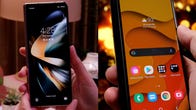

Now playing:
Watch this:
Comparing Samsung Galaxy Z Fold 3 and Z Fold 4 Specs
7:07
Samsung also upgraded the Z Fold 4’s camera system. On the back, there are three cameras consisting of a 50-megapixel main sensor, 12-megapixel ultrawide sensor and 10-megapixel telephoto lens. That telephoto lens will support optical zoom up to 3x and digital zoom up to 10x. There are also two “front cameras.” The most discernible one is a 10-megapixel sensor found on the main display of the Z Fold 4, and the other is a 4-megapixel under-display camera in the interior screen.
Apart from the specs changes, Samsung emphasized its aim to design more sustainable foldable phones. The Fold 4 uses components made from repurposed fishing nets, in a first for Samsung’s foldables. In particular, the display’s connector cap and the side key bracket are made from discarded fishing nets, and there are other recycled parts inside the phone. That said, it’s hard to determine how meaningful these changes are without a teardown.
Speaking of sustainability, Samsung says the Z Fold 4 incorporates more durable materials. Its main cover now relies on an “optimized layer structure,” which offers improved damage protection. All that is backed up by the usual aluminum frames, and Gorilla Glass Victus on the cover and rear.


Now playing:
Watch this:
Samsung Galaxy Z Fold 4 First Take: Bigger Cover Screen,…
5:43
The Z Fold 4 still doesn’t have dust-resistance, which is likely a tradeoff for the foldable design. It retains last year’s IPX8 rating, which means it can be submerged in up to 1.5 meters of freshwater for as long as 30 minutes. By comparison, the Galaxy S22 lineup has IP68 water- and dust-resistance, meaning the phones can withstand dust, dirt and sand. They can also be submerged up to 1.5 meters underwater for up to 30 minutes.
There’s still no S Pen storage slot, but Samsung has launched a case with an S Pen holder, which is sold separately. For more information on how Samsung’s innovative Z Fold lineup has evolved over the years, take a look at CNET’s specs chart below.
For more, check out how the Galaxy Z Flip and Galaxy Watch models compare.
Galaxy Z Fold 4 vs. Z Fold 3 vs. Z Fold 2
| Galaxy Z Fold 4 5G | Galaxy Z Fold 3 5G | Galaxy Z Fold 2 | |
|---|---|---|---|
| Display size, resolution | Internal: 7.6-inch AMOLED (2,176 x 1,812 pixels); External: 6.2-inch HD+ (2,316 x 904) | Internal: 7.6-inch AMOLED (2,208 x 1,768 pixels); External: 6.2-inch AMOLED (2,268 x 832 pixels); | Internal: 7.6-inch Dynamic AMOLED; External: 6.2-inch Dynamic AMOLED; 2,260 x 816 + 2,208 x 1,768 pixels |
| Pixel density | TBC | 387ppi (external) + 374ppi (internal) | 386ppi (external) + 373ppi (internal) |
| Dimensions (Millimeters) | Folded: 67.1×155.1×15.8mm (Hinge) ~14.2mm(Sagging). Unfolded: 130.1×155.1×6.3mm | Folded: 67x158x16mm (hinge) ~14.4mm (sagging). Unfolded: 128x158x6.4mm | Folded: 68.0×159.2×16.8mm (hinge) ~13.8mm (sagging). Unfolded: 128.2×159.2×6.9mm (frame) ~6.0mm (screen) |
| Weight (Ounces, Grams) | 9.27 oz; 263g | 9.56 oz; 271 g | 10 oz; 282 g |
| Mobile software | Android 12L | Android 11 | Android 10 |
| Camera | 50-megapixel (main), 12-megapixel (ultra-wide), 10-megapixel (telephoto) | 12-megapixel (ultrawide), 12-megapixel (wide), 12-megapixel (telephoto) | 12-megapixel (main) + 12-megapixel (wide angle) + 12-megapixel (telephoto) |
| Front-facing camera | 4-megapixel (under display), 10-megapixel (front cover) | 4-megapixel (under display), 10-megapixel (front cover) | 10-megapixel, 10-megapixel |
| Video capture | 4K | 4K | 4K |
| Processor | Snapdragon 8 Gen Plus 1 | Qualcomm Snapdragon 888 | Snapdragon 865 Plus |
| RAM/Storage | 12GB + 256GB/512GB/1TB | 12GB + 256GB/512GB | 12GB + 256 GB |
| Expandable storage | None | None | None |
| Battery/Charger | 4,400 mAh | 4,400 mAh | 4,500 mAh |
| Fingerprint sensor | Side | Side | Side |
| Connector | USB-C | USB-C | USB-C |
| Headphone jack | None | None | None |
| Special features | Foldable phone, 30x optical, 30x space zoom, IPX8, 25-watt fast-charging (no in-box charger) | 5G-enabled; Foldable display, 120Hz refresh rate (front cover and main display), IPX8 water-resistance, S Pen support | Foldable display, 120Hz refresh rate, wireless charging support |
| Price (USD) | $1,800 (256 GB); Pricing for other models TBC | $1,800 (256GB); $1,900 (512GB) | $1,999 |
| Price (GBP) | TBC | £1,599 (256GB); £1,699 (512GB) | £1,799 |
The post Samsung Galaxy Z Fold 4 vs. Galaxy Z Fold 3 vs. Galaxy Z Fold 2: A Spec first appeared on Joggingvideo.com.
]]>The post Samsung Galaxy Z Flip 4 vs. Z Flip 3 vs. Z Flip (2020): Comparing the Foldables first appeared on Joggingvideo.com.
]]>Samsung announced the Galaxy Z Flip 4 at Wednesday’s Samsung Unpacked event, succeeding last year’s Galaxy Z Flip 3 and continuing the line of clamshell foldable phones that began with 2020’s Galaxy Z Flip. The new phone was announced alongside the Galaxy Z Fold 4, the new Galaxy Watch 5 line and the Galaxy Buds 2 Pro during the Wednesday livestream.
Flip 4 presales kick off today (early birds are treated to a memory upgrade, free case and trade-in credit) ahead of its official release on Aug. 26, when it will go on sale for $1,000 (£999, AU$1,499). That puts the price in line with other flagship phones such as Apple’s iPhone 13 Pro and Samsung’s Galaxy S22 Plus.
More from Samsung Unpacked
- Samsung Unpacked: Galaxy Z Fold 4, Z Flip 4 and Every Reveal
- Samsung Galaxy Z Fold 4: Better Design, Same High Price
- Samsung’s Galaxy Z Flip 4 Gets New Software Tricks
New to the Z Flip 4 is a larger 3,700-mAh battery, faster charging speeds that reach approximately 50% in 30 minutes and an upgraded Snapdragon 8 Plus Gen 1 processor.
But perhaps the most noteworthy changes — at least on paper — were made to the software. Samsung’s taking advantage of the phone’s foldable shape by making the cover screen more useful. Now you can reply to texts, unlock your car or take selfies without ever flipping open the device. Samsung has also added customization features for the cover screen as well as the inner screen.


Now playing:
Watch this:
Samsung Galaxy Z Flip 4 and Z Flip 3 Specs Compared
7:05
With the Z Flip 4, Samsung said it refined its design by slimming down the hinge and straightening the edges. It also has a pair of 10-megapixel rear cameras and a 10-megapixel front-facing sensor.
While the Z Flip 4 makes some improvements to its predecessor, it’s more of a refinement than a refresh. You can see the details for yourself in CNET’s chart below, which offers a side-by-side comparison of Samsung’s stylish flip phones. You can learn more about Samsung’s new foldables by checking out how the Galaxy Z Fold models compare.
Z Flip 4 vs. Z Flip 3 vs. Z Flip (2020)
| Galaxy Z Flip 4 | Z Flip 3 | Galaxy Z Flip | |
|---|---|---|---|
| Display size, resolution, aspect ratio | Main Screen: 6.7-inch FHD+ (2,640 x 1080 pixels; 22:9) Cover Screen: 1.9-inch (260×512 pixels) | Internal: 6.7-inch FHD+ AMOLED; (2,640×1,080 pixels); External: 1.9-inch AMOLED (512×260 pixels) | Internal: 6.7-inch FHD+ Dynamic AMOLED; 2,636×1,080 pixels / External: 1.1-inch Super AMOLED; 300×112 pixels |
| Pixel density | TBC | 425ppi (internal) / 303ppi (external) | 425ppi (internal) / 303ppi (external) |
| Dimensions (Millimeters) | Folded: 71.9 x 84.9 x 17.1mm (Hinge) – 15.9mm (Sagging); Unfolded: 71.9 x 165.2 x 6.9mm | Folded: 72.2 x 86.4 x 171.1mm Hinge: ~15.9mm (Sagging) Unfolded:72.2 x 166.0 x 6.9mm | Folded: 75.9 x 87.3 x 15.7 ~ 17.2mm / Unfolded: 75.9 x 167.3 x 6.8 ~7.1mm |
| Weight (Ounces, Grams) | 187g; 6.59 oz | 6.46 oz; 183g | 6.46 oz; 183g |
| Mobile software | Android 12 | Android 11 | Android 10 |
| Camera | 12-megapixel (main), 12-megapixel (ultra-wide) | 12-megapixel (wide), 12-megapixel (ultrawide) | 12-megapixel (wide-angle), 12-megapixel (ultra wide-angle) |
| Front-facing camera | 10-megapixel | 10-megapixel | 10-megapixel |
| Video capture | 4K | 4K | 4K (HDR 10+) |
| Processor | Qualcomm Snapdragon 8 Plus Gen 1 | Qualcomm Snapdragon 888 | Qualcomm Snapdragon 855+ (64-bit octa-core) |
| RAM/Storage | 8GB+ 128GB/256GB/512GB | 8GB + 128GB/ 256GB | 8GB + 256GB |
| Expandable storage | None | None | None |
| Battery/Charger | 3,700 mAh | 3,300 mAh | 3,300 mAh |
| Fingerprint sensor | Side | Side | Power button |
| Connector | USB-C | USB-C | USB-C |
| Headphone jack | No | No | No |
| Special features | IPX67, 5G enabled, foldable display, wireless charging, 25W fast charging | 5G enabled, foldable display, wireless charging, reverse wireless charging, 15W fast charging | Foldable display; wireless PowerShare; wireless charging; fast charging |
| Price (USD) | $1,000 | $1,000 (128GB); $1,050 (256GB) | $1,380 |
| Price (GBP) | £949 (128GB); £999 (256GB) | £949 (128GB); £999 (256GB) | £1,300 |
| Price (AUD) | AU$1,499 (128GB); AU$1,599 (256GB) | AU$2,499 (128GB); AU$2,649 | Converts to AU$2,067 |
The post Samsung Galaxy Z Flip 4 vs. Z Flip 3 vs. Z Flip (2020): Comparing the Foldables first appeared on Joggingvideo.com.
]]>The post Xiaomi Unveils Super Slim Foldable Phone, the Mix Fold 2 first appeared on Joggingvideo.com.
]]>
Xiaomi unveiled a second-gen foldable phone on Thursday, rounding off a busy week of foldable phone launches that saw Samsung and Motorola reveal foldables of their own.
The Mix Fold 2, a follow-up to the Chinese company’s inaugural foldable phone, is a book-style foldable that Xiaomi is marketing for its ultraslim design, among other features. When folded, the device measures 11.2mm, which means it’s the world’s slimmest commercially available book-style foldable phone. It’s approximately 4mm thinner than Samsung’s recently launched Galaxy Z Fold 4. Xiaomi credits its “micro waterdrop” hinge for helping achieve the slim design, which allows for a tighter fold on the flexible display panel within the 8.8mm-tall hinge structure.
The Mix Fold 2 features two displays: A 6.56-inch panel on the cover, which expands into an 8-inch interior screen when you open it up. As for cameras, there’s one 20-megapixel front-facing sensor and three cameras on the rear, including a telephoto camera.
Just in case you missed it, here’s a recap of #XiaomiMIXFold2 with all the important features at a glance! pic.twitter.com/3UxdyuK3a2
— leijun (@leijun) August 11, 2022
The Mix Fold 2 runs on Qualcomm’s latest Snapdragon 8 Gen Plus 1 chipset, the same one found in Samsung and Motorola’s latest foldable phones. It also has a Harman Kardon dual-speaker setup, a 4,500-mAh double-cell battery and 67-watt fast charging support. The base version of the Mi Mix Folds is priced at 8,999 yuan, which converts to approximately $1,330, £1,090 or AU$1,860. It will be released in mainland China only.
Despite the flurry of launches this week, foldable phones account for just a sliver of the overall smartphone market, although shipments grew dramatically in 2021 compared to 2020. According to the International Data Corporation, 7.1 million foldables were shipped in 2021, marking a 264.3% increase from 2020.
The Mix Fold 2 was announced at a virtual event alongside a human-sized robot and a bevy of other Xiaomi products, including a new tablet and a budget phone.
The post Xiaomi Unveils Super Slim Foldable Phone, the Mix Fold 2 first appeared on Joggingvideo.com.
]]>